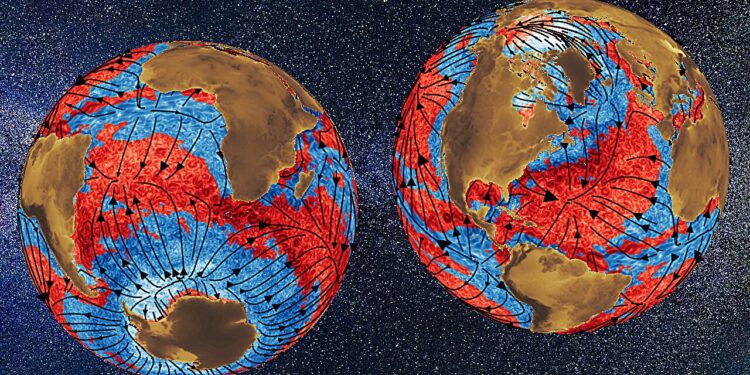This illustration by Benjamin Storer shows ocean weather systems (mesoscale eddies) from data overlaid with climate-scale atmospheric currents (black lines), which can be extracted using a granulation technique coarse developed in the laboratory of Hussein Aluie. The image reveals how these ocean weather systems are energized (red) or weakened (blue) as they interact with climate scales, following a pattern reflecting global atmospheric circulation. Credit: University of Rochester/Benjamin Storer
An international team of scientists has discovered the first direct evidence linking seemingly random weather systems in the ocean and global climate. Led by Hussein Aluie, an associate professor in the University of Rochester’s department of mechanical engineering and a scientist in the University’s Laser Energy Laboratory, the team reported their findings in Scientists progress.
The ocean has weather patterns similar to those we experience on land, but on different time and length scales, says lead author Benjamin Storer, a research associate in Aluie’s Turbulence and Complex Flow group. A weather phenomenon on land can last a few days and be about 500 kilometers wide, while ocean weather phenomena, such as swirling eddies, last three to four weeks but are about a fifth the size.
“Scientists have long speculated that these ubiquitous and seemingly random movements in the ocean communicate with climate scales, but this has always remained vague because it was unclear how to untangle this complex system to measure their interactions,” says Aluie. “We developed a framework that can do just that. What we discovered was not what people expected because it requires the mediation of the atmosphere.”
The group’s goal was to understand how energy flows through different channels in the planet’s oceans. They used a mathematical method developed by Aluie in 2019, which was then implemented in advanced code by Storer and Aluie, which allowed them to study the transfer of energy on different models ranging from the circumference of the globe to 10 kilometers. These techniques were then applied to ocean datasets from an advanced climate model and satellite observations.
The study found that ocean weather systems are both energized and weakened as they interact with climate scales, and in a pattern that mirrors global atmospheric circulation. The researchers also discovered that an atmospheric band near the equator called the “intertropical convergence zone,” which produces 30 percent of the world’s precipitation, causes intense energy transfer and produces ocean turbulence.
Storer and Aluie say it’s not easy to study such complex fluid movement at multiple scales, but it has advantages over previous attempts to link weather to climate change. They believe the team’s work creates a promising framework for better understanding the climate system.
“There’s a lot of interest in how global warming and climate change influence extreme weather events,” says Aluie. “Usually, these research efforts are based on statistical analysis that requires a lot of data to have confidence in the uncertainties. We are taking a different approach based on mechanistic analysis, which alleviates some of these requirements and allows us to understand more easily causes and effects.”
The team that played a central role in the investigation also included Michele Buzzicotti, a research scientist at the University of Rome Tor Vergata; Hemant Khatri, research associate at the University of Liverpool, and Stephen Griffies, senior scientist at Princeton.
More information:
Benjamin Storer et al, Global Ocean Kinetic Energy Cascade and Atmospheric Footprint, Scientists progress (2023). DOI: 10.1126/sciadv.adi7420. www.science.org/doi/10.1126/sciadv.adi7420
Provided by the University of Rochester
Quote: Scientists discover link between ocean weather and global climate, using mechanical rather than statistical analysis (December 20, 2023) retrieved December 20, 2023 from
This document is subject to copyright. Apart from fair use for private study or research purposes, no part may be reproduced without written permission. The content is provided for information only.



